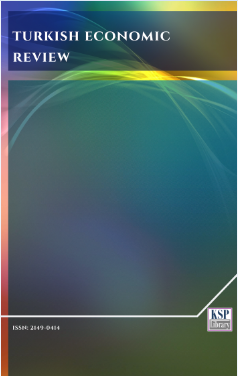The Impact of Age Distribution on Household Consumption: Evidence from Saudi Arabia
Abstract
Abstract. This paper aims to analyze the impact of age distribution on household consumption at the aggregate level. For that, statistical and econometric techniques are used, such as Unit root test, Co-integration and Granger Engels causality through Vector Error Correction Model, for testing an eventual short and long run causal relationships. This study is important since it helps to develop efficient national strategies for the short and the long run according to the evolution of the demographic profile and structure. Empirical validation for the Saudi Arabian case shows that the causality’s effect differs significantly according to consider the size versus the proportion of each age group. In addition, the analysis and discussions of results for each age categories gave specific conclusions for the overtime causality effect on Saudi Arabian household final consumption.
Keywords. Age distribution, Consumption, Causality, Cointegration; Statistical tests.
JEL. C22, D12, J11.
References
Aliyu, A.J., & Tijjani, S.M. (2015) Asymmetric cointegration between exchange rate and trade balance in Nigeria. Cogent Economics & Finance, 3, 1045213, 1-19. doi. 10.1080/23322039.2015.1045213
Attfeld, C.L.F. (2002). Short and long run trend forecasts of the impact of an ageing population on per capita Aggregate consumers' expenditure. Discussion Paper, University of Bristol.
Attfield, C.L.F., & Cannon, E. (2003). The impact of age distribution variables on the long run consumption function. Discussion Paper, No. 03/546, University of Bristol.
Bosworth, B., Burtless, G., & Sabelhaus, J. (1991). The decline in saving: Evidence from household survey. Brookings Papers on Economic Activity, 1, 183-241.
Doornik, J.A., & Hendry, D.F. (2015). Statistical model selection with “Big Data”. Cogent Economics & Finance, 3, 1045216, 1-15. doi. 10.1080/23322039.2015.1045216
Dutta. A. (2015). Improved calendar time approach for measuring long-run anomalies. Cogent Economics & Finance, 3, 1065948, 1-14. doi. 10.1080/23322039.2015.1065948
Engle, F. Robert and Granger, C.W.J. (1987). Co-Integration and Error Correction: Representation, Estimation and Testing. Econometrica, 55(2), 251-276.
Erlandsen, S., & Nymoen, R. (2008). Consumption and population age structure. Journal of Population Economics, 21(3), 505-520. doi. 10.1007/s00148-006-0088-5
Estrada, G.D.P., & Ramayandi, A. (2011). Population aging and aggregate consumption in developing Asia. ADB Economics Working Paper Series No. 282.
Fair, C.R., & Dominguez, M.K. (1991). Effects of the Changing U.S. Age Distribution on Macroeconomic Equations. American Economic Review, 81(5), 1276-94.
Haj-Kacem, R.B. (2014). Cointegration and causality between economic growth and social development in Saudi Arabia. Journal of Knowledge Management, Economics and Information Technology. 4(2), 1-15.
Hajamini, M., & Falahi, M.A. (2014). The nonlinear impact of government consumption expenditure on economic growth: Evidence from low and low-middle income countries. Cogent Economics & Finance, 2, 948122. 1-15. doi. 10.1080/23322039.2014.948122
Higgins, M. (1998). Demography, National Saving, and International Capital Flows. International Economic Review, 39(2), 343-369. doi. 10.2307/2527297
Hong, K. (2005). Macroeconomic impacts of population aging in Korea. Department of Eocnomics Working Paper, Ewha University.
Horioka, C.Y. (1997). A Cointegration Analysis of the Impact of the Age Structure of the Population on the Household Saving Rate in Japan. Review of Economics and Statistics, 79(3), 511-516. doi. 10.1162/rest.1997.79.3.511
Ibrahim, M., & Hook, L.S. (2013). Dynamic of consumer expenditure and stock market prices and uncertainty: Malaysian evidence. The Singapore Economic Review, 58(4), 1-17. doi. 10.1142/S0217590813500252
Johansen, S.M., Mosconi, R., & Nielsen, B. (2000). Cointegration analysis in the presence of structural breaks in the deterministic trend. Econometrics Journal, 3(2), 216-249. doi. 10.1111/1368-423X.00047
Masson, P., Bayoumi, T., & Samei, H. (1996). International Evidence on the Determinants of Private Saving. Discussion Paper Series N 1368, CEPR.
Modigliani, F., & Brumberg, R. (1954). Utility Analysis and the Consumption Function: An Interpretation of Cross-Section Data. In Kurihara, K. (ed.), Post-Keynesian Economics, 388-436. New Brunswick: Rutgers University Press.
Parker, J.A. (1999). Spendthrift in America? On Two Decades of Decline in the U.S. Saving Rate. In Bernanke, B. and J. Rotemberg (eds.), NBER Macroeconomics Annual, 317-370. MIT Press, Cambridge, Massachusetts.
United Nations (2012). World Population Prospects: The 2012 Revision.
DOI: http://dx.doi.org/10.1453/ter.v2i4.532
Refbacks
- There are currently no refbacks.
.......................................................................................................................................................................................................................................................................................................................................
Turkish Economic Review - Turk. Econ. Rev. - TER - www.kspjournals.org
ISSN: 2149-0414
Editor: [email protected] Secretarial: [email protected] Istanbul - Turkey.
Copyright © KSP Library




